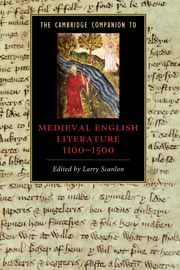Introduction
Published online by Cambridge University Press: 28 November 2009
Summary
About 1300, somewhere in the north of England, on the eve of what would prove to be one of the most remarkable centuries in all of Anglophone literary tradition, a cleric, most likely a monk, sat down to write a history of the world from Creation to Judgment Day. It would consist mainly of biblical paraphrase. He called it the Cursor Mundi, literally “the runner of the world”: “For almast it overrrennes all.” This work comes down to us in nine manuscripts, not an inconsiderable number, especially as they show a wide geographical distribution. But it is almost unknown except among scholars of Middle English literature, and even among them, it is not especially well read. At first glance, it seems to confirm the worst stereotypes about medieval literary culture. Clearly derivative, ostensibly little more than a very long exercise in plot summary, it would seem to offer little in the way of poetic originality, and not much of poetic value of any sort. The manuscripts suggest that the work found an audience, perhaps even a sizable one. Yet that would seem only to make the poem even more foreign - a religious work for a religious age. The literary values we might identify in such a work seem notable only for their stark differences from our own.
However, in point of fact, the Cursor Mundi is quite a lively, sophisticated, and poetically accomplished work. An obvious aspect of its sophistication occurs in its introduction, where the author meditates on precisely those issues that seem to mark its difference: its religiosity, its relation to previous tradition and its notion of its prospective readership. He treats all of them as specifically poetic problems. The first two lines declare, “Man yhernes rimes for to here / And romances red on manners sere” (i–2(: Man yearns to hear rhymes / And romances read in various manners). The couplet initially seems to treat “rimes” and “romances” as identical, an impression reinforced by the next twenty lines, which catalog many of the period’s most popular romances, such as the tales of Alexander, the Arthurian cycle, Charlemagne, and Tristan and Isolde.
- Type
- Chapter
- Information
- Publisher: Cambridge University PressPrint publication year: 2009

